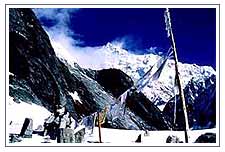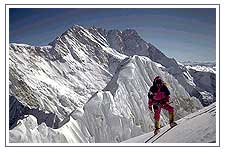
Kangchenjunga
(Kanchenjunga) has remained virgin and unconquered, inspite of the several
attempts furnished with the most modern equipments till 1975. Within
7,000-sq-kms area is contained the world's third highest 8,586m, but
the most romantic mountain.
Kangchenjunga (Kanchenjunga) is located on the Sikkim (India) - Nepal
border as part of the Himalayan mountain range. Kangchenjunga has 5 peaks,
of which the true Summit is 28,169 feet or 8,586 meters. The name
Kangchenjunga (Kanchenjunga) means "The Five Treasures of the Snow"
in the local dialect, referring to its five summits all over 8,000 meters.
Kangchenjunga has an enormous mass with numerous satellite peaks along its
ridges. Kangchenjunga is located at Latitude 27° 42' 9'' Longitude 88°
9' 1 '. Kangchenjunga (Kanchenjunga) is also known by some as named "Kangchen
Dzö-nga", "Kachendzonga", "Kangchanfanga".
Climbing Attempts At Kangchenjunga
In 1930, a European expedition
consisting of German, Austrian, Swiss and British mountaineers made an
attempt to scale Kangchenjunga, it failed. Years later a writer came across
an extract from the diary of one of the climbers, who wrote:
"Kangchenjunga (Kanchenjunga) had beaten us... we had examined
every portion of the faces above the Kangchenjunga and Rathong glaciers;
nowhere was there a chink in the armour of the giant. Others sceptical as to
the truth-may follow... like us they will lie awake at night and tremble,
even as the ground trembles at the roar of great ice avalanches that seek
their destruction... their hope and optimism... ruthlessly crushed
beneath the icy heel of Kangchenjunga."
In June, 1955 a British expedition under charles evans sent a telegram to
the 'Times", it read:
"Summit of Kangchenjunga less five vertical feet reached on May 25.
All well." The expedition stopped short of the top-they had agreed to
respect the religious feelings of the Sikkimese who regard the mountain as
sacred and had undertaken not to desecrate the immediate neighbourhood of
the summit.
Sir John Hunt, who reached the peak of Everest with Sir edmund Hillary and
Tenzing Norkey, has described it, a mountain more difficult and dangerous to
climb, than Everest itself.
Mighty Majesty
The people of Sikkim depend on the good humour of the
deity enthroned on a summit - 'has he not the power to destroy human
habitations with devastating floods and avalanches...and ruin crops by
sending terrible hailstorms'- he is portrayed as a fiery red
counteranced deity with a crown of five skulls, riding the mythical snow
lion, and holding aloft the banner to victory. Seasoned mountaineers hold
Khang-Chen-Dzod-Nga in awe and credit it with a cordon drawn around the
summit beyond which man may bot enter.
There is an annual festival of ritual and dance dedicated to the 'Worship
of the snow range of Khang-Chen-Dzog-Nga, during the early part of Autumn.
As in the classical days of Greek Gods who danced atop Mount Olympus, Lamas
dressed in the impressive masks and broacades of the God, prance and whirl
against the backdrop of the mountain itself.
Kangchenjunga Trek

Kangchenjunga
(Kanchenjunga) is situated on the eastern border of Nepal. Its main peak is
the third highest in the world (8,586 m). several other peaks in the
Kangchenjunga range are over 8,000m. This trek to this area is probably the
best that trekking has to offer in terms of lush natural beauty. Travelling
into the Yalung glacier and over the Lapsang la and down the difficult route
back to Taplejung is an unforgettable experience. However, as the trip
crosses the 4,000m mark several times, one must take care of high altitude
sickness.
Kangchenjunga Trek Info:
Region : Eastern Nepal
Highest Trekking Altitude : 4,560m
Duration : 18-Days From Kathmandu To Biratnagar
Season : April To October
Though
foreigners need to obtain a permit to visit sikkim, getting one is a mere
formality. The easiest way is to request one when applying for your Indian
visa. They are usually valid for two weeks from entry into the state, which
allows enough time to visit the towns and villages at a fairly leisurely
pace but places constraints on time if trekking.
The permit covers the main southern belt from Gangtok across to
Pemayangtse. Certain area in central Sikkim and the sensitive border regions
with Tibet are completely off limits to foreigners. Other parts of Sikkim
are open for Tourism but not included in the regions covered by your permit.
For those areas you require an endorsement of your permit, a simple quick
and free service which is provided at the Tourist Information Office in
Gangtok. Visa extensions and trekking permits for certain regions can also
be obtained in Gangtok. Certain restricted areas, like Changu Lake, Yumthang
and Dzongri, only allow foreigners in groups, accompanied by representatives
of approved travel agents.


 Kangchenjunga
(Kanchenjunga) has remained virgin and unconquered, inspite of the several
attempts furnished with the most modern equipments till 1975. Within
7,000-sq-kms area is contained the world's third highest 8,586m, but
the most romantic mountain.
Kangchenjunga
(Kanchenjunga) has remained virgin and unconquered, inspite of the several
attempts furnished with the most modern equipments till 1975. Within
7,000-sq-kms area is contained the world's third highest 8,586m, but
the most romantic mountain.  Kangchenjunga
(Kanchenjunga) is situated on the eastern border of Nepal. Its main peak is
the third highest in the world (8,586 m). several other peaks in the
Kangchenjunga range are over 8,000m. This trek to this area is probably the
best that trekking has to offer in terms of lush natural beauty. Travelling
into the Yalung glacier and over the Lapsang la and down the difficult route
back to Taplejung is an unforgettable experience. However, as the trip
crosses the 4,000m mark several times, one must take care of high altitude
sickness.
Kangchenjunga
(Kanchenjunga) is situated on the eastern border of Nepal. Its main peak is
the third highest in the world (8,586 m). several other peaks in the
Kangchenjunga range are over 8,000m. This trek to this area is probably the
best that trekking has to offer in terms of lush natural beauty. Travelling
into the Yalung glacier and over the Lapsang la and down the difficult route
back to Taplejung is an unforgettable experience. However, as the trip
crosses the 4,000m mark several times, one must take care of high altitude
sickness.